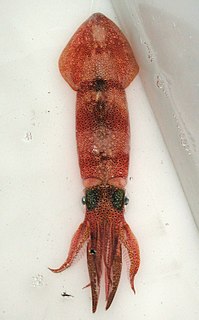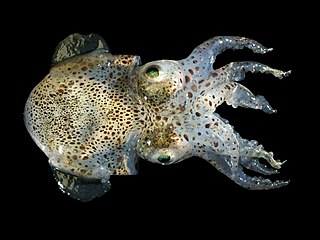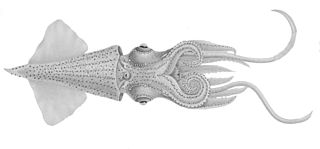
The Gonatidae, also known as armhook squid, are a family of moderately sized squid. The family contains about 19 species in three genera, widely distributed and plentiful in cold boreal waters of the Pacific Ocean. At least one species is known from Antarctic waters, and two from the North Atlantic. The genus Eogonatus was created for the species known as Eogonatus tinro because it did not have hooks on the tentacular club and it has 5 rows of teeth on the radula. Molecular studies in allozymes and mitochondrial DNA have indicated that this species nests within the genus Gonatus, although other authorities treat it as a synonym of Gonatopsis okutanii.

Ommastrephidae is a family of squid containing three subfamilies, 11 genera, and over 20 species. They are widely distributed globally and are extensively fished for food. One species, Todarodes pacificus, comprises around half of the world's cephalopod catch annually.

Doryteuthis plei, also known as the slender inshore squid or arrow squid, is a medium-sized squid belonging to the family Loliginidae. It occurs abundantly in coastal waters of the Atlantic Ocean, from Argentina northward to North Carolina.

Liocranchia is a genus of glass squid from the family Cranchiidae. They are moderate-sized with a long, spindle-shaped mantle which tapers to a point at the rear and they can attain mantle lengths of 250 mm. The species in Liocranchia have a cosmopolitan distribution in tropical and subtropical oceans although it has been suggested that on especies, Liocranchia reinhardti is associated with land masses. In seas off Hawaii waters L. reinhardti undergoes vertical migrations while L. valdiviae occurs in deep water is sedentary. They are eaten by many oceanic predator species.

Sepiola atlantica, also known as the Atlantic bobtail, is a species of bobtail squid native to the northeastern Atlantic Ocean and the Mediterranean Sea.

Enoploteuthis is a genus of squid in the family Enoploteuthidae. The species of Enoploteuthisare most easily recognised by having a larger tail when compared to the other genera in the Enoploteuthidae. The tail's size is emphasised not having the fins extending along its sides. In related genera there is a narrow extension of the fins along the tail. Other characteristics include the presence of suckers on the distal portion of arms IV where there at no photophores present; the tentacular club has two rows of hooks and no marginal suckers; on the buccal crown there are typical chromatophores on the aboral surface but on the oral surface there may be some light skin pigmentation. They have 9-10 photophores on the eye and they have complex photophores in the skin. In the females the Spermatangia receptacles are at the posterior junction of muscles used to retract the funnel and the muscles which retract the head. Enoploteuthis differs from other genera of the Enoploteuthidae in having two rather than three types of photophores in its integument and these are on the ventral areas of the head, funnel and mantle. All species of Enoploteuthis which have been studied have the most complex type of photophoreand seems to be a distinctive characteristic of this genus. Enoploteuthis contains the largest species in the family, attaining a mantle length of 130mm.

Heteroteuthis dispar, also known as the odd bobtail, is a small deep water squid found in the North Atlantic Ocean and the Mediterranean Sea.

Teuthowenia megalops, sometimes known as the Atlantic cranch squid, is a species of glass squid from the subarctic and temperate waters of the northern Atlantic Ocean. They are moderately sized squid with a maximum mantle length of 40 cm (16 in). Their very large eyes are the source for the specific name megalops. Like other members of the genus Teuthowenia, they are easily recognizable by the presence of three bioluminescent organs (photophores) on their eyeballs.

Neorossia caroli, the Carol bobtail squid, is a species of bobtail squid belonging to the family Sepiolidae.

Euprymna morsei, the Mimika bobtail squid, is a species of Indo-Pacific bobtail squid from the family Sepiolidae.
Afrololigo mercatoris, commonly known as the Guinean thumbstall squid, is a small species of squid in the family Loliginidae from the eastern central Atlantic Ocean. It is the only species in the monotypic genus Afrololigo.

Doryteuthis is a genus of squid from the waters of the western Atlantic and eastern Pacific off the coast of the Americas species are the common inshore squids of American waters. Some species are important quarry species for fisheries.
Loliolus is a genus of squid from the family Loliginidae from the Indo-Pacific region. The genus is divided into two subgenera Loliolus and Nipponololigo. They are small squids of less than 150mm in mantle length which have an expanded tentacular club. This club has 4 series of suckers. The sucker ringss have plate-like teeth which are square in shape all around them. The males' hectocotylus has a ventral crest which is created by the fusion of the protective membrane with the ventral series of papillae and this crest completely obscures the conical shape of the papillae. The mantle is rounded posteriorly and lacks the posterior tail-like lobe while the fins are positioned on the rear of the mantle and extend to the posterior tip of the mantle. Their eggs are small and the males' spermatophore has a short cement body. They do not possess photophores. The two subgenera are distinguished by the hectocotylus which in Loliolus encompasses the enire arm and there are no unmodified suckers while in Nipponololigo the arm is only partly hectocotylsed and has normal suckers at its base.

Slosarczykovia is a monotypic genus of squid, its sole representative being Slosarczykovia circumantarctica. Slosarczykovia is placed in the family Brachioteuthidae.

Enoploteuthis leptura, the hooked enope squid, is a species of squid from the family Enoploteuthidae. It is the type species of the genus Enoploteuthis, which is in turn the type genus of the Enoploteuthidae.

Lampadioteuthis megaleia is a small, colorful squid from the family Lycoteuthidae, it is the only species in the only genus in the monotypic subfamily Lampadioteuthinae, it is sometimes known as the wonderful firefly squid. It differs from the other species of the Lycoteuthidae mainly by having a hectocotylus in the males and by the possession of a rostrum on the gladius.
Eucleoteuthis is a monotypic genus of squid from the family Ommastrephidae, the only species is Eucleoteuthis luminosa, the striped flying squid or luminous flying squid.
Ornithoteuthis volatilis, the shiny bird squid, is a squid from the subfamily Ommastrephinae, the flying squids, of the family Ommastrephidae part of the pelagic squid order Oegopsida. It is a tropical and sub-tropical species which is widely distributed in the Indo-Pacific oceans. It is slightly larger than the closely related species Ornithoteuthis antillarum of the Atlantic Ocean.


















